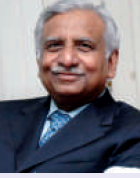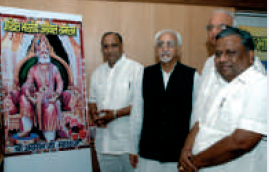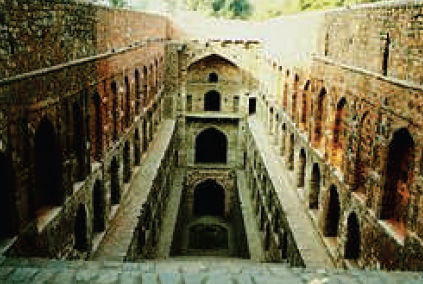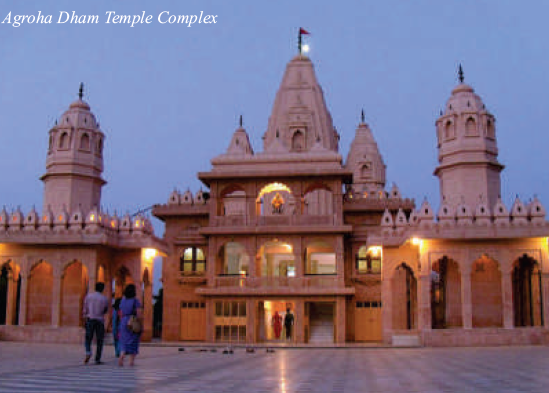Agroha
This is a collection of articles archived for the excellence of their content. Readers will be able to edit existing articles and post new articles directly |
Agroha
This paragraph has been extracted from THE IMPERIAL GAZETTEER OF INDIA , 1908. OXFORD, AT THE CLARENDON PRESS. |
Ancient town in the Fatahabad tahsil of Hissar Dis- trict, Punjab, situated in 29 degree 20' N. and 75 degree 38' E ,13 miles north of Hissar. It is said to be the original seat of the Agarwal Banias, and was once a place of great importance. The remains of a fort are still visible about half a mile from the existing village, and ruins and debris half buried in the soil on every side attest its former greatness. It was captured by Muhammad of Ghor in 1194, since which time the Agarwal Banias have been scattered over the whole peninsula. The clan comprises many of the wealthiest men in India. The present village is quite unimportant and has (1901) a population of only 1,172.
Agroha
The lost kingdom of Maharaja Agrasena
India Harmony VOLUME - 1 : ISSUE - 5 JULY-AUGUST, 2012
It is a matter of great pride to all Indians when Billionaire Laxmi Mittal is internationally recognized as one of the world's richest Indians. Another such international celebrity is Anil Agarwal, Chairman of Vedanta Group, who has created ripples in the Global mining business. Then there are the leading agarwal business families from Haryana, the Jindal Group and Subhash Chandra Goyal of Zee telefilms. What do these families share in common? How did they scale such great heights in such a short period? Could it be because they are all from the Agarwal community and are descendants of the renowned King Agrasen?
Agrawals are basically a commercial community or Vaishyas. They are one of the most respectable and enterprising of mercantile tribes. Two of Emperor Akbar's famous ministers are said to have been Agrawals, viz, Todarmal, who introduced an assessment of land, and Madhushah, who introduced 'Madhushahi' pice.
Maharaja Agrasena was a legendary Indian king of Agroha in India, a city of traders, from whom the Agrawal and Agrahari community claims descent. He is credited with the establishment of a kingdom of traders in North India, and is known for his compassion in refusing to slaughter animals in yajnas.
Agrasen is known to be a king of the Solar Dynasty who adopted Vanika dharma for the benefit of his people. Literally, Agrawal means the "children of Agrasena" or the "people of Agroha", a city in ancient Kuru Panchala, near Hisar in Haryana said to be founded by Agrasena. Noted Hindi author Bharatendu Harishchandra (himself an Agrawal) wrote Agarwalon ki Utpatti (The origin of Agrawals) in 1871, based on an account in the Mahalaksmi Vrat Katha manuscript. According to this account, Maharaja Agrasena was a Suryavanshi Kshatriya king, born during the last stages of Dwapar Yuga in the Mahabharat epic era; he was contemporary of Lord Krishna. Agrasen ki Baoli in Delhi is believed to be originally built by the king Agrasen during the Mahabharat epic era and rebuilt in the 14th century by the Agrawal community, who traces its origin to King Agrasen.
All this may have passed off as a legendary tale had it not been for the discovery of the Agroha mound located about 1.5 km from Agroha village in Hisar District. Buried under the mound were the remains of an ancient town found during excavations in 1859. These remains caused great excitement in the Agarwal community and in 1976 the Agroha Vikas Trust was established by the All India Aggarwal Sabha. The ancient capital of King Agrasen had been discovered and the community finally found its roots.
How Agroha became the capital of Maharaj Agrasen's empire makes interesting reading. Agrasena was the eldest son of the King Ballabh of Pratapnagar.
Agrasena attended the swayamvara of Madhavi, the daughter of the King Nagaraj. However, Indra, the God of Heaven and also the Lord of storms and rainfall, wanted to marry Madhavi, but she chose Agrasena as her husband. A furious Indra decided to take revenge by making sure that Pratapnagar did not receive any rain. As a result, a famine struck Agrasen's kingdom, who then decided to wage a war against Indra. Sage Narada was approached by Indra, who mediated peace between Agrasena and Indra. The condition was that Agrasena and Madhavi must leave Pratapnagar forever.
Agrasena started a severe tapasya (penance) to propitiate Lord Shiva in the city of Kashi. Shiva was pleased with the penance and advised him to propitiate Goddess Mahalakshmi. Agrasena began to meditate on Mahalakshmi, who appeared before him and blessed him. She urged Agrasena (who was a Kshatriya) to take up the Vaishya tradition of business for the sake of the prosperity of his people. She asked him to establish a new kingdom, and promised that she would bless his descendants with prosperity.
Agrasena then traveled all over India with his queen to select a place for a new kingdom. At one point during his travels, he found a few tiger cubs and wolfs cubs playing together. To King Agrasena and Queen Madhavi, this was an indication that the area was veerabhoomi (land of the brave) and they decided to found their new kingdom at that location. The place was named Agroha. Agroha is situated near present day Hisar in Haryana.
Under the leadership of Agrasena, Agroha became very prosperous. Legend has it that a hundred thousand traders lived in the city at its heyday. An immigrant wishing to settle in the city would be given a rupee and a brick by each of the inhabitants of the city. Thus, he would have a hundred thousand bricks to build a house for himself, and a hundred thousand rupees to start a new business.
Another legend recounts that Agrasena conducted 18 mahayajnas ("Great yajnas"). During one such yajna, Agrasena noticed that a horse that had been brought to be sacrificed was trying hard to get away from the sacrificial altar. Seeing this Maharaj Agrasena was filled with compassion for the animal. The idea of ahimsa (non-violence) grabbed his mind. Therefore, he put a stop to his eighteenth yajna, and announced that no further sacrifices would be made in his kingdom in the name of yajnas.
The kingdom of Agrasen flourished and extended from
the Himalayas, Punjab, the Yamuna valley, and the
Mewar region. Agra was the capital of the southern
part of the kingdom. The other important regions were
Gurgaon (ancient Gaudagrama), the mother goddess of
this place is revered by Agrawals; Meerut, Rohtak,
Hansi, Panipat, Karnal, and Kotkangra. Mandi,
Vilaspur, Garhwal, Narnaul were also parts of the
kingdom. Agroha was the capital of this large empire.
Agrasena divided his kingdom among his 18 children, resulting in eighteen Agrawal gotras. Often, the number of gotras is stated to be seventeen. In the letter part of his life, Agrasena nominated his eldest son Vibhu to the throne and took up the Vanaprastha ashram (Renunciation). Gradually, the city of Agroha declined and was finally destroyed in a huge fire. The residents of Agroha i.e. the Agrawals moved out of Agroha and spread to other parts of India. Seventeen and a half gotras of Agrawals: Airan, Bansal, Bindal, Bhandal, Dharan, Garg, Goyal, Goyan (considered as half gotra), Jindal, Kansal, Kuchhal, Madhukul, Mangal, Mittal, Nangal, Singhal, Tayal, Tingle.
In recent decades the Agroha Vikas Trust has taken up development of the area. 27 acres of land were donated by Sh. L. N. Gupta at 1976. The Government of India issued a postage stamp in honour of Maharaja Agrasen at that time. Since then large scale development has taken place. The Agroha Dham has been set up as a centre of learning, philosophy and spirituality. The temple complex deserves special mention as it houses a temple dedicated to the goddesses Mahalaxmi and Saraswati, A memorial to Maharaj Agrasen and Shakti Sarovar are surrounded by lush green lawns. A little away stands the ancient temple of Sheela Mata, which is an important pilgrim centre.
The Maharaja Agrasen Medical Institute has been established by the great visionary Mr. O.P. Jindal to provide selfless service and new opportunities to the local people. With the strong commitment of the Agarwal community Agroha is poised to shine again as an abiding symbol of Maharaja Agrasen's message of peace, non-violence, sacrifice, compassion and socialism.









